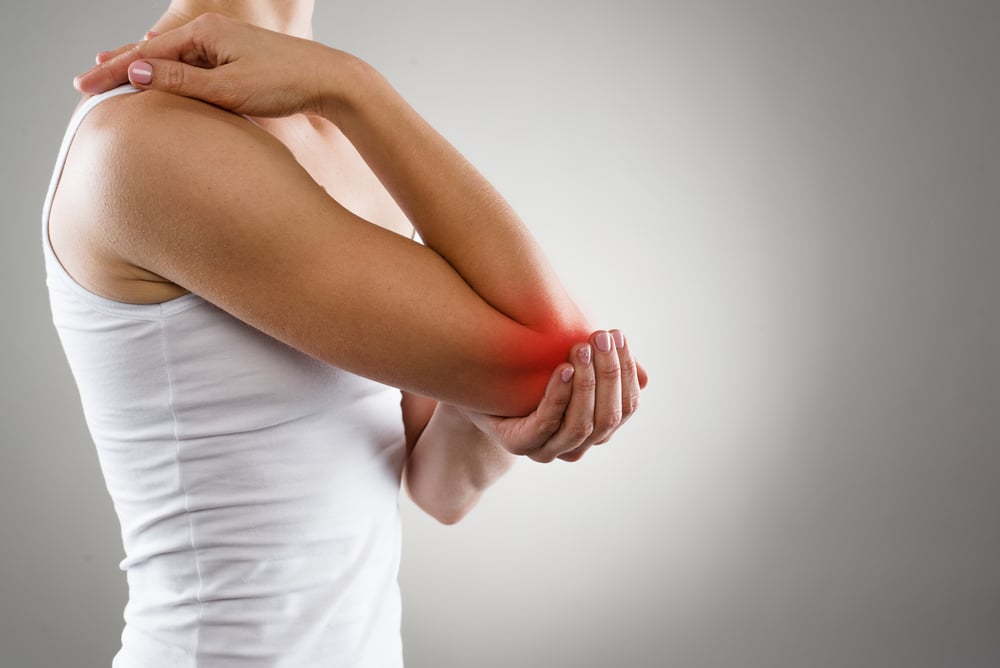This website uses cookies so that we can provide you with the best user experience possible. Cookie information is stored in your browser and performs functions such as recognising you when you return to our website and helping our team to understand which sections of the website you find most interesting and useful.

It’s important to note that while these factors can increase the risk of developing elbow arthritis, not everyone with these risk factors will develop this condition. Additionally, some patients may develop elbow arthritis without any clear underlying cause. Treatment for elbow arthritis typically focuses on managing symptoms, reducing inflammation, and improving joint function. This may involve medications, physical therapy, lifestyle modifications, and, in severe cases, surgical intervention.

Elbow arthritis, like arthritis in other joints, can develop due to various factors. Here are some common causes:
Age: As people get older, the cartilage in their joints can naturally wear down over time. This degeneration can lead to arthritis.
Joint Overuse: Repetitive stress or overuse of the elbow joint, often seen in occupations or activities that involve repetitive arm movements, heavy lifting, or sports like tennis or baseball, can contribute to the development of arthritis.
Joint Trauma: Previous injuries to the elbow joint, such as fractures, dislocations, or severe sprains, can increase the risk of developing arthritis in the affected joint. Even after the injury has healed, the joint may be more susceptible to degeneration and inflammation.
Genetics: Some individuals may have a genetic predisposition to developing arthritis, making them more susceptible to the condition.
Autoimmune Conditions: Inflammatory autoimmune diseases like rheumatoid arthritis can affect multiple joints, including the elbow. In these conditions, the body’s immune system mistakenly attacks the synovium, the lining of the membranes that surround the joints, leading to inflammation and joint damage.
Infections: In rare cases, infections in the elbow joint can cause arthritis. This is known as septic arthritis and requires prompt medical treatment.
Metabolic Disorders: Certain metabolic disorders, such as gout or pseudogout, can cause crystals to form within the joint, leading to inflammation and arthritis.
Obesity: Excess body weight can put added stress on the joints, including the elbows, increasing the risk of developing arthritis.
If you are experiencing arthritis in your elbow and need treatment, please contact us at Fair Oaks Orthopedics. Our professional medical staff can help you to relieve your pain by simply calling us today.
Elbow arthritis occurs when there is inflammation and degeneration of the joints in the elbow. The most common type of arthritis affecting the elbow is osteoarthritis, but other types such as rheumatoid arthritis and post-traumatic arthritis can also occur. Here are some potential causes and risk factors for elbow arthritis:
Osteoarthritis (Degenerative arthritis): This type of arthritis typically occurs due to wear and tear on the joints over time. Factors that can contribute to osteoarthritis in the elbow include repetitive stress on the joint from activities such as heavy lifting, manual labor, sports that involve throwing or repetitive arm movements, and previous joint injuries or fractures.
Rheumatoid arthritis: Rheumatoid arthritis is an autoimmune disorder in which the body’s immune system mistakenly attacks the synovium, the lining of the membranes that surround the joints. This can lead to inflammation, pain, and eventual joint damage. While rheumatoid arthritis more commonly affects the smaller joints, such as those in the hands and feet, it can also affect larger joints, like the elbows.
Post-traumatic arthritis: Elbow arthritis can develop following a significant injury or trauma to the elbow joint, such as a fracture or dislocation. Even after the initial injury has healed, the damage to the joint structures can predispose the individual to develop arthritis in the affected joint over time.
Other inflammatory conditions: such as psoriatic arthritis or ankylosing spondylitis can also cause arthritis in the elbows, although this is less common.
Genetic predisposition: Some patients may have a genetic predisposition to developing arthritis, making them more susceptible to the condition.
- Age: As with many forms of arthritis, the risk of developing elbow arthritis increases with age, as the cartilage in the joints naturally wears down over time.
- Obesity: Excess body weight can put added stress on the joints, including those in the elbow, increasing the risk of developing arthritis.
- Occupational factors: Jobs or activities that involve repetitive movements or heavy lifting can increase the risk of developing arthritis in the elbow joint.
Symptoms of Elbow Arthritis May Include:
Pain: Persistent or intermittent pain in the elbow joint, especially during movement or weight-bearing activities.
Stiffness: Difficulty bending or straightening the elbow fully, particularly after periods of inactivity or when waking up in the morning.
Swelling: Visible swelling or tenderness around the elbow joint, often accompanied by warmth to the touch.
Limited Range of Motion: Difficulty fully extending or flexing the elbow, leading to decreased mobility and functional limitations.
Clicking or Grinding Sensations: Some patients may experience audible or palpable sensations of clicking, popping, or grinding within the elbow joint during movement.
Weakness: In the arm or hand due to pain and reduced function in the affected elbow joint.
Treatment for elbow arthritis typically focuses on relieving pain, reducing inflammation, and improving joint function. This may include medications, physical therapy, lifestyle modifications, and, in some cases, surgical intervention such as elbow joint replacement or arthroscopic surgery. Patients with elbow arthritis should work closely with our orthopedic staff to create an appropriate treatment plan based on their specific medical needs and circumstances.
Medications
Prescription medications can help to reduce your joint pain and swelling and, in the case of rheumatoid or psoriatic arthritis, to prevent damage to your joints.
- Acetaminophen. Helps relieve pain.
- Nonsteroidal anti-inflammatory drugs. Reduces pain and swelling in your affected joints. Examples include ibuprofen, diclofenac, naproxen, celecoxib. Topical NSAIDs are the first topical treatment of choice for osteoarthritis.
- Disease-modifying antirheumatic drugs. These medications slow the progress of rheumatoid arthritis and relieve symptoms. Examples include methotrexate, hydroxychloroquine, sulfasalazine (Azulfidine®), leflunomide (Arava®).
- Corticosteroids. Can be taken by orally, injected into your muscle or given by IV, these medications reduce inflammation and other symptoms of rheumatoid arthritis. Examples include prednisolone, prednisone, triamcinolone and methylprednisolone.
- Immunosuppressive drugs. These medications slow down the progress of rheumatoid arthritis and reduce damage to bone surrounding the affected joints. Examples include azathioprine and cyclosporine.
- Biologic agents. These medications can slow joint damage in rheumatoid arthritis. Examples include adalimumab (Humira®), etanercept (Enbrel®), infliximab (Remicade®), tofacitinib (Xeljanz®), tocilizumab (Actemra®), abatacept (Orencia®), rituximab (Rituxan®).
Steroid injections
Steroids reduce inflammation and relieve pain. Steroids are usually used if medications don’t manage the inflammation or if the inflammation is limited to a few joints. Injections are added directly into the affected joint.
Other strategies
- Exercises—to strengthen and stretch, reduce symptoms to improve elbow function. One of our hand therapists can work with you to give you the best exercises to help your arthritis.
- Hot and cold packs. Cold can help reduce pain and swelling. Heat can help reduce stiffness.
- Rest. Regular rest periods can help relieve pain and inflammation in your joints.
- Healthy eating and managing other health conditions that affect your arthritis such as diabetes and high cholesterol levels.
- Weight loss
- Stop Smoking as it increases the risk of developing arthritis.
- Occupational therapy is offered.
There are several surgical options based on the type and severity of your arthritis and your overall health. Dr. Stephen W. Pournaras Jr., will discuss options & help you decide which is best for you.
The most common surgical procedures are:
- Synovectomy- involving the removal of diseased or damaged lining of the joints
- Osteotomy- is the realignment of the bones in a joint
- Arthroplasty- joint replacement surgery, most common for advanced arthritis
Most surgeries are followed by elbow therapy, which strengthens the muscles and improves function. We also offer this therapy.
Surgery is recommended to our patients with severe symptoms such as pain, swelling, significant sleep interference, muscle weakness, the beginning of joint deformity. If you haven’t had any relief of your symptoms with at least 6-8 weeks of the non-surgical treatment options please contact us.
Mon 8:00 am – 4:30 pm
Tue 8:00 am – 4:30 pm
Wed 8:00 am – 4:30 pm
Thu 8:00 am – 4:30 pm
Fri 8:00 am – 4:30 pm
Sat Closed
Sun Closed

